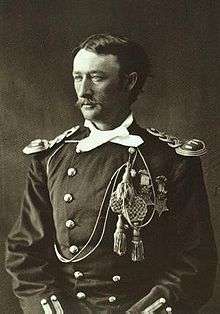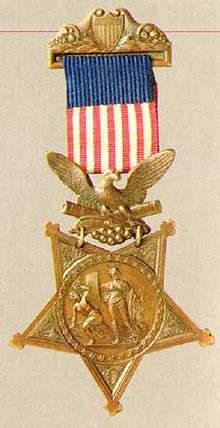Thomas Custer
| Thomas Ward Custer | |
|---|---|
 Captain Thomas W. Custer, two-time Medal of Honor recipient | |
| Born |
March 15, 1845 New Rumley, Ohio |
| Died |
June 25, 1876 (aged 31) Little Bighorn, Montana Territory |
| Place of burial | Fort Leavenworth National Cemetery |
| Allegiance |
Union |
| Service/branch |
Union Army |
| Years of service | 1861–1876 |
| Rank |
|
| Unit |
7th U.S. Cavalry (1866–76) |
| Commands held | Company C, 7th U.S. Cavalry |
| Battles/wars | |
| Awards | Medal of Honor (2) |
Thomas Ward Custer (March 15, 1845 – June 25, 1876) was a United States Army officer and two-time recipient of the Medal of Honor for bravery during the American Civil War. He was a younger brother of George Armstrong Custer, perishing with him at Little Bighorn in the Montana Territory.
Early life and Civil War
He was born in New Rumley, Ohio, the third son of Emanuel and Marie Custer. He enlisted in the Union Army, in September 1861, at age 16, and served in the early campaigns of the Civil War as a private in the 21st Ohio Volunteer Infantry.[1] He saw action at numerous battles, including Stones River, Missionary Ridge and the Atlanta Campaign. He mustered out in October 1864 as a corporal. Commissioned a second lieutenant in Company B of the 6th Michigan Cavalry, he became his brother's aide-de-camp and accompanied him throughout the last year of the war.

Tom Custer distinguished himself by winning successively the brevets of captain, major, and lieutenant colonel, although he was barely 20 years of age when the Civil War ended. He was awarded two Medals of Honor. He was the first soldier to receive the dual honor, one of only four soldiers or sailors to receive the dual honor during the Civil War, and one of just 19 in history.
Medals of Honor
Both actions that earned Custer the Medal of Honor involved capturing Confederate regimental flags (2nd North Carolina Cavalry flag at Namozine Church on April 3, 1865, and again at Sailor's Creek on April 6, 1865).[2] Such battle flags "denoted individual persons, or units, on the field of battle. The flag symbolized the honor of the regiment...In combat, with the field full of noise and smoke, the soldiers watched their regimental flag and if it advanced or retreated they followed. The names of the battles that the regiment participated in were sometimes stitched onto the flag. The loss of a regimental flag was a disgrace to the command."[3]
First Award
Custer earned his first Medal of Honor for actions during the Battle of Namozine Church, April 3, 1865.[2] Among Union forces charging Confederate barricades, Custer had his horse leap a barricade while coming under fire. The Confederates fell back in confusion before him, while he saw a color bearer. Racing forward he seized the flag of the Second North Carolina cavalry from the bearer and commanded those around him to surrender. He took three officers and eleven enlisted men prisoner, took them behind the federal column and requisitioned another horse as his had been shot in the charge.[3]
Second Award
Similar actions in the Battle of Sailor's Creek resulted in Custer being the first American soldier to receive two Medals of Honor. Riding alongside Colonel Charles E. Capehart when the command to charge was given, he raced his horse toward the enemy barricades through a line of rifle fire, then leapt the barricade to be surrounded by the enemy. He discharged his pistol to both sides, scattering the enemy. He noticed Confederates attempting to make a new battleline and saw the color bearer they were rallying to.[3] Custer charged the bearer. Colonel Capehart reported the rest of the events in a letter to Libbie Custer:
"I saw your brother capture his second flag. It was in a charge made by my brigade at Sailor's Creek, Virginia, against General Ewell's Corps. Having crossed the line of temporary works in the flank road, we were confronted by a supporting line. It was from the second line that he wrested the colors, single-handed, and only a few paces to my right. As he approached the colors he received a shot in the face which knocked him back on his horse, but in a moment he was upright in his saddle. Reaching out his right arm, he grasped the flag while the color bearer reeled. The bullet from Tom's revolver must have pierced his heart. As he was falling Captain Custer wrenched the standard from his grasp and bore it away in triumph."— Colonel Capehart[3]
(Pictures taken shortly after the battle show a scar "with minor soft tissue damage to his lower jaw extending to a point just below the right ear";[3] though the wound to Tom's face was across blood rich tissue and covered him in his own blood, had the bullet gone through the mouth or the soft tissue of the neck it would have likely struck a major vessel and have caused him to bleed to death.)[3] Having captured the flag Custer held it aloft and rode back to the Union column. An officer of the Third New Jersey cavalry, seeing Custer ride back with the banner flapping, tried to warn him that he might be shot by his own side: "For God's sake, Tom, furl that flag or they'll fire on you!"[3] Custer ignored him and kept riding towards his brother Armstrong's personal battle flag and handed the captured flag to one of Armstrong's aides while declaring, "Armstrong, the damned rebels shot me, but I've got my flag."[3] Custer then turned his horse to rejoin the battle, but Armstrong (who had only seconds before seen another of his aides be shot in the face and fall from his horse dead) ordered Custer to report to the surgeon. Tom ignored the order and his brother placed him under arrest, ordering him to the rear under guard.[3]
Date of actions
Until 1948, official references for the date of actions for which Thomas Custer was awarded the Medal of Honor were listed as April 2 and 6, 1865. However, that year a U.S. Army book on Medal of Honor citations listed the dates as May 11, 1863, and April 6, 1865.[4] Consolidated lists of all Medal of Honor citations were published by the U.S. Senate in 1963, 1973, and 1979 with the incorrect first date of May 11, 1863 and in 1963 and 1973 with the correct second date of April 6, 1865. The 1979 edition published the second date as April, 1865, and this would seem to be why the online Army Medal of Honor citations at United States Army Center of Military History[5] has two incorrect dates. The Civil War Army recipient that follows Thomas Custer alphabetically is Byron Cutcheon whose date of action was May 10, 1863, which may explain how the first date for Thomas Custer appeared as May 10, 1863.[6]
Indian Wars
Following the war, Custer was appointed first lieutenant in the 7th Cavalry in 1866. He was wounded in the Washita campaign of the Indian Wars, in 1868. He later served on Reconstruction duty in South Carolina and participated in the Yellowstone Expedition of 1873, where he fought in the Battle of Honsinger Bluff, and the Black Hills Expedition of 1874. He was appointed captain in 1875 and given command of Company C of the 7th Cavalry. In 1874, at the trading post at Standing Rock Agency, Custer participated in the arrest of the Lakota Rain-in-the-Face for the 1873 murder of Dr. John Honsinger.
During the 1876 Little Bighorn campaign of the Black Hills War, he served as aide-de-camp to Lt. Col. George A. Custer and died with his brother on June 25, 1876. Lt. Henry Harrington actually led Company C during the battle. Younger brother Boston Custer also died in the fighting, as did other Custer relatives and friends. It was widely rumored that Rain-in-the-Face, who had escaped from captivity and was a participant at the Little Bighorn, cut out Tom Custer's heart after the battle; though the chief later denied it during an interview. Custer's remains were identified by a recognizable tattoo of his initials on his arm.
Tom Custer was buried on the battlefield, but exhumed the next year and reburied in Fort Leavenworth National Cemetery. A stone memorial slab marks the place where his body was discovered and initially buried.
In November 1868, following the Battle of Washita River, George Custer was alleged (by Captain Frederick Benteen, chief of scouts Ben Clark, and Cheyenne oral tradition) to have unofficially married Mo-nah-se-tah, daughter of the Cheyenne chief Little Rock in the winter or early spring of 1868–1869. (Little Rock was killed in the Washita battle.)[7] Mo-nah-se-tah gave birth to a child in January 1869, two months after the Washita battle. Cheyenne oral history tells that she also bore a second child, fathered by Custer in late 1869. Some historians, however, believe that George Custer had become sterile after contracting gonorrhea while at West Point and that the father was, in actuality, his brother Thomas.[8] A descendant of the second child, who goes by the name Gail Custer, wrote a book about the affair.[9]
See also
Notes
- ↑ Goodman, Rebecca (2005). "This Day in Ohio History". Emmis Books. p. 268. Retrieved 21 November 2013.
- 1 2 http://www.history.army.mil/moh/civilwar_af.html#COHN
- 1 2 3 4 5 6 7 8 9 Carl F. Day (2002). Tom Custer: ride to glory. University of Oklahoma Press.
- ↑ The Medal of Honor of the United States Army, Government Printing Officer, Washington, 1948.
- ↑ "United States Army Center of Military History". United States Army Center of Military History. August 3, 2009. Retrieved January 6, 2010.
- ↑
- ↑ Utley, Robert M. (2001). Cavalier in Buckskin: George Armstrong Custer and the Western Military Frontier, revised edition. Norman, OK: University of Oklahoma Press. ISBN 0-8061-3387-2, p. 107.
- ↑ Wert (1996), pp. 287–288.
- ↑ Gail Custer, George's great-great-granddaughter
References
 This article incorporates public domain material from websites or documents of the United States Army Center of Military History.
This article incorporates public domain material from websites or documents of the United States Army Center of Military History.
- "Civil War Medal of Honor recipients (A-L)". Medal of Honor citations. United States Army Center of Military History. August 6, 2009. Retrieved July 1, 2010.
External links
- Thomas and George Custer Tobacco Return for 7th Cavalry, 1875 Shapell Manuscript Foundation